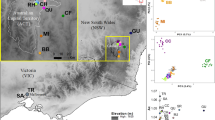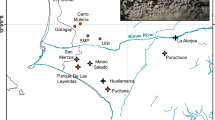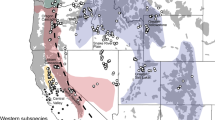Abstract
Population dynamics of Canada lynx (Lynx canadensis) have been of interest to ecologists for nearly sixty years1,2,3,4. Two competing hypotheses concerning lynx population dynamics and large-scale spatial synchrony are currently debated. The first suggests that dispersal is substantial among lynx populations5, and the second proposes that lynx at the periphery of their range exist in small, isolated patches that maintain cycle synchrony via correlation with extrinsic environmental factors2. Resolving the nature of lynx population dynamics and dispersal is important both to ecological theory and to the conservation of threatened lynx populations: the lack of knowledge about connectivity between populations at the southern periphery of the lynx's geographic range delayed their legal listing in the United States6. We test these competing hypotheses using microsatellite DNA markers and lynx samples from 17 collection sites in the core and periphery of the lynx's geographic range. Here we show high gene flow despite separation by distances greater than 3,100 km, supporting the dispersal hypothesis. We therefore suggest that management actions in the contiguous United States should focus on maintaining connectivity with the core of the lynx's geographic range.
This is a preview of subscription content, access via your institution
Access options
Subscribe to this journal
Receive 51 print issues and online access
$199.00 per year
only $3.90 per issue
Buy this article
- Purchase on Springer Link
- Instant access to full article PDF
Prices may be subject to local taxes which are calculated during checkout


Similar content being viewed by others
References
Elton, C. S. & Nicholson, M. The ten-year cycle in numbers of the lynx in Canada. J. Anim. Ecol. 11, 215–244 (1942).
Stenseth, N. C. et al. Common dynamic structure of Canada lynx populations within three climatic regions. Science 285, 1071–1073 (1999).
Ranta, E., Kaitala, V. & Lunberg, P. The spatial dimension in population fluctuations. Science 278, 1621–1623 (1997).
Blasius, B., Huppert, A. & Stone, L. Complex dynamics and phase synchronization in spatially extended ecological systems. Nature 399, 354–359 (1999).
McKelvey, K. S., Aubry, K. B. & Ortega, Y. K. in Ecology and Conservation of Lynx in the United States (eds Ruggiero, L. F. et al.) 207–264 (Univ. Press of Colorado, Denver, 2000).
Federal Register. Endangered and threatened wildlife and plants; determination of threatened status for the contiguous U.S. distinct population segment of the Canada lynx and related rule; final rule. Federal Register 65, 16051–16086 (2000).
Ruggiero, L. F. et al. in Ecology and Conservation of Lynx in the United States (eds Ruggiero, L. F. et al.) 443–454 (Univ. Press of Colorado, Denver, 2000).
Moran, P. A. P. The statistical analysis of the Canadian lynx cycle. II. Synchronization and meteorology. Aust. J. Zool. 1, 291–298 (1953).
Wright, S. Evolution and the Genetics of Populations Vol. 2 The Theory of Gene Frequencies (Univ. Chicago Press, Chicago, 1969).
Whitlock, M. & McCauley, D. Indirect measures of gene flow and migration: F st not equal to 1/(4Nm+1). Heredity 82, 117–125 (1999).
Waples, R. S. Separating the wheat from the chaff: patterns of genetic differentiation in high gene flow species. J. Hered. 89, 438–450 (1998).
Cornuet, J., Piry, S., Luikart, G., Estoup, A. & Solignac, M. New methods employing multilocus genotypes to select or exclude populations as origins of individuals. Genetics 153, 1989–2000 (1999).
Manuel, S., Bertier, P. & Luikart, G. Detecting wildlife poaching: identifying the origin of individuals with Bayesian assignment tests and multilocus genotypes. Cons. Biol. (in the press).
Slough, B. G. & Mowat, G. Lynx populations dynamics in an untrapped refugium. J. Wildl. Mgmt 60, 946–961 (1996).
Mowat, G., Poole, K. G. & O'Donoghue, M. in Ecology and Conservation of Lynx in the United States (eds Ruggiero, L. F. et al.) 265–306 (Univ. Press of Colorado, Denver, 2000).
Roy, M. S., Geffin, E., Smith, D., Ostrander, E. A. & Wayne, R. K. Patterns of differentiation and hybridization in North American wolf-like caids revealed by analysis of microsatellite loci. Mol. Biol. Evol. 11, 553–570 (1994).
Forbes, S. H. & Boyd, D. Genetic structure and migration in native and re-introduced Rocky Mountain wolf populations. Cons. Biol. 11, 1226–1234 (1997).
Paetkau, D., Shields, G. F. & Strobeck, C. Gene flow between insular, coastal and interior populations of brown bears in Alaska. Mol. Ecol. 7, 1283–1292 (1998).
Hudson, P. J. & Cattadori, I. M. The Moran effect: a cause of synchrony. Trends Ecol. Evol. 14, 1–2 (1999).
Grenfell, B. T. et al. Noise and determinism in synchronized sheep dynamics. Nature 394, 674–677 (1998).
Cattadori, I. M., Merler, S. & Hudson, P. J. Searching for mechanisms of synchrony in spatially structured gamebird populations. J. Anim. Ecol. 69, 620–638 (2000).
Greenman, J. V. & Benton, T. G. The impact of stochasticity on the behaviour of nonlinear population models: synchrony and the Moran effect. Oikos 93, 343–351 (2001).
Predavec, M., Krebs, C. J., Danell, K. & Hyndman, R. Cycles and synchrony in the collared lemming (Dicrostonyx groenlandicus) in Arctic North America. Oecologia 126, 216–224 (2001).
Ehrich, D. et al. Spatial structuring of lemming populations (Dicrostonyx groenlandicus) fluctuating in density. Mol. Ecol. 10, 481–496 (2001).
Menotti-Raymond, M. A. & O'Brien, S. J. Evolutionary conservation of ten microsatellite loci in four species of Felidae. J. Hered. 86, 319–322 (1995).
Menotti-Raymond, M. A. et al. A genetic linkage map of microsatellites in the domestic cat (Felis catus). Genomics 57, 9–23 (1999).
Schwartz, M. K., Mills, L. S., Allendorf, F. W. & Ruggiero, L. F. Landscape location affects genetic variation of Canada lynx (Lynx canadensis). Mol. Ecol. (submitted).
Berthier, P., Beaumont, M., Cornuet, J.-M. & Luikart, G. Likelihood-based estimation of the effective population size using temporal changes in allele frequencies: a genealogical approach. Genetics (in the press).
Acknowledgements
We thank the following people and institutions for providing samples: C. Apps, T. Bailey, H. Golden, G. Jarrell, J. Cook, M. Hebblewhite, Montana Fish Wildlife and Parks, J. Kolbe, R. Mulders, B. Naney, R. Oakleaf, L. Roy, B. Scotton, T. Shurry, H. Slama and J. Squires. We thank H. Draheim, B. Adams, B. Theroux, S. Forbes, P. Spruell and K. Pilgrim for laboratory support and advice. This project was funded by the USDA/USFS (grant to L.S.M. and M.K.S.), and NSF (grant to L.S.M.); M.K.S. was additionally funded by a McIntire-Stennis grant, the USFS Rocky Mountain Research Station, and the NSF Training-WEB. We thank R. Biek, S. Forbes, G. Luikart, D. Pletscher, M. Poss, D. Tallmon and E. Winer for comments on earlier versions of this manuscript. All pertinent local, national and international permits required for this project are on file at the University of Montana.
Author information
Authors and Affiliations
Corresponding author
Ethics declarations
Competing interests
The authors declare no competing financial interests.
Rights and permissions
About this article
Cite this article
Schwartz, M., Mills, L., McKelvey, K. et al. DNA reveals high dispersal synchronizing the population dynamics of Canada lynx. Nature 415, 520–522 (2002). https://doi.org/10.1038/415520a
Received:
Accepted:
Issue Date:
DOI: https://doi.org/10.1038/415520a
This article is cited by
-
Network experiment demonstrates converse symmetry breaking
Nature Physics (2020)
-
Heterogeneous network promotes species coexistence: metapopulation model for rock-paper-scissors game
Scientific Reports (2018)
-
Behaviour and reproductive fitness of postdispersal in plateau pikas (Ochotona curzoniae) on the Tibetan Plateau
Mammal Research (2018)
-
Lack of sex-biased dispersal promotes fine-scale genetic structure in alpine ungulates
Conservation Genetics (2014)
-
Applications and techniques for non-invasive faecal genetics research in felid conservation
European Journal of Wildlife Research (2013)
Comments
By submitting a comment you agree to abide by our Terms and Community Guidelines. If you find something abusive or that does not comply with our terms or guidelines please flag it as inappropriate.



